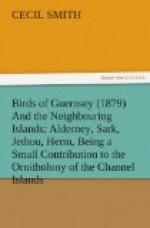In bringing my labours to a conclusion I must again thank Mr. MacCulloch and others, who have assisted me in my work either by notes or by helping in out-door work.
FINIS.
ENDNOTES.
[1] a Alderney.
e Guernsey.
i Jersey.
o Sark.
u Jethou and Herm.]
[2] This was nearly the whole of the Vale, including L’Ancresse Common.
[3] Fourteen “livres tournois” are about equal to L1.
[4] This Act is passed annually at the Chief Pleas after Easter.
[5] Falco aesalon, Tunstall, H.S. 1771. Falco aesalon, Gmelin, Y., 1788.
[6] See Temminok.
[7] See ‘Birds of Spain,’ by Howard Saunders, Esq., published in the works of the Societe Zoologique de France, where he says:—“C. ceruginosus et C. cyaneus ont les lisieres exterieures des remiges emarginees, jusqu’a et y comprise la cinquieme, et cette forme se trouve en presque toutes les Circus exotiques. En C. swainsonii (the Pallid Harrier) et C. cineraceus cette emargination successive se borne a la quatrieme.” We have little to do with this distinction, except as between C. cyaneus and C. cineraceus, C. aeruginosus being otherwise sufficiently distinct, and C. swainsonii not coming within our limits.
[8] “Tereus,” I soon found, as I expected, was Mr. MacCulloch.
[9] These reeds are the common reed Spires, Spire-reed, or Pool-reed. Arundo phragmites. See ‘Popular Names of British Plants,’ by Dr. Prior, p. 219.
[10] This name of Temminck is no doubt applied to the Continental form, Acredula caudata, of Linnaeus, not to the British form now elevated into a species under the name Acredula rosea, of Blyth. Owing to want of specimens I have not been able to say to which form the Channel Island Long-tailed Tit belongs, probably supposing them to be really distinct from A. rosea. A. caudata may, however, also occur, as both forms do occasionally, in the British Islands.
[11] See Temminck’s ‘Man. d’Ornith.’
[12] Dresser’s ‘Birds of Europe,’ fide Degland’s Grebe.
[13] Where both forms are common this constantly happens—indeed, so constantly that Professor Newton, in his new edition of ‘Yarrell,’ has made but one species of the Black Crow and the Grey or Hooded Crow, Corvus corone and Corvus cornix, on the several grounds that there is no structural difference between the two; that their habits, food, cries, and mode of nidification are the same (in considering this, of course both forms must be traced throughout the whole of their geographical range, and not merely through the British Islands); that their geographical distribution is sufficiently similar not to present any difficulty; that they breed freely together; and




